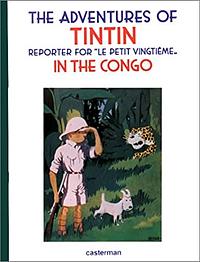You need to sign in or sign up before continuing.
Take a photo of a barcode or cover
Second book in the series is way, way better than the first one (Tintin in the land of Soviets) in both graphical presentation and consistency of the story.
Story itself seems to be a popular view at the time of Africa, European African colonies and native people. Especially of Congo, Belgian colony, that was ruthlessly exploited while ran as personal fiefdom of Leopold II, king of Belgium, until it was, at the end of first decade of 20th century, made part of Belgium state territory.
With that said portrayal of native people is very simplistic and will definitely be offending today (although to be honest as far as I can see this volume was found to be offending even in 60's and 70's). Keep in mind this was written in 1930's and story reflects the period with all its racial stereotypes and prejudices.
Second element that remained controversial with this book is approach to wildlife - Tintin is presented as a big-games hunter that came to Africa to hunt down every signature animal from Africa (lion, rhino, elephant) for his news report. Again this is part of the story that will be offending to many today but at the time big game hunters were celebrities (and let us not forget that unfortunately this practice continues even today with hunt-safari's).
So if you are aiming at politically correct works then this one is not for you.
Improvements over the volume #1 are in art (we can see the art becoming much better and comic is starting to look like Tintin we know today) and consistency of the story. Although nature of comic (serialization in newspaper over the months) is more than obvious, story itself is much more cohesive and does not read like just a collection of short gags.
All in all much better book than volume #1 and one that shows bright future for Tintin.
Story itself seems to be a popular view at the time of Africa, European African colonies and native people. Especially of Congo, Belgian colony, that was ruthlessly exploited while ran as personal fiefdom of Leopold II, king of Belgium, until it was, at the end of first decade of 20th century, made part of Belgium state territory.
With that said portrayal of native people is very simplistic and will definitely be offending today (although to be honest as far as I can see this volume was found to be offending even in 60's and 70's). Keep in mind this was written in 1930's and story reflects the period with all its racial stereotypes and prejudices.
Second element that remained controversial with this book is approach to wildlife - Tintin is presented as a big-games hunter that came to Africa to hunt down every signature animal from Africa (lion, rhino, elephant) for his news report. Again this is part of the story that will be offending to many today but at the time big game hunters were celebrities (and let us not forget that unfortunately this practice continues even today with hunt-safari's).
So if you are aiming at politically correct works then this one is not for you.
Improvements over the volume #1 are in art (we can see the art becoming much better and comic is starting to look like Tintin we know today) and consistency of the story. Although nature of comic (serialization in newspaper over the months) is more than obvious, story itself is much more cohesive and does not read like just a collection of short gags.
All in all much better book than volume #1 and one that shows bright future for Tintin.
I knew going into this that it was going to be racist. I just didn't realize HOW racist. The native Congolese population is drawn like monkeys. *shudder*
adventurous
medium-paced
Plot or Character Driven:
Character
Strong character development:
N/A
Loveable characters:
Yes
Diverse cast of characters:
No
Flaws of characters a main focus:
No
Includes racism and animal killings but negligible
challenging
medium-paced
Loveable characters:
Complicated
Diverse cast of characters:
Complicated
God damn it, [a:Hergé|2802356|Hergé|https://images.gr-assets.com/authors/1595847562p2/2802356.jpg].
It is difficult to review [b:Tintin in the Congo|235140|Tintin in the Congo (Tintin, #2)|Hergé|https://i.gr-assets.com/images/S/compressed.photo.goodreads.com/books/1539043132l/235140._SX50_.jpg|1752679].
On one hand, one has to take into consideration that it was published during the 30's. On the other hand, ir contains many solid elements of racism, white savior complex, animal abuse, animal cruelty, and obvious obnoxious caricatures.
While the adventures of Tintin and Snowy are still astounding, expeditiously, and really fun to read about, it was at times uncomfortable to read this one in the modern era that we live in.
However, I still cherish this second installment as a record for how twisted the world view was almost hundred years ago, and how far we have come since then. And for that, it was worth reading it.
It is difficult to review [b:Tintin in the Congo|235140|Tintin in the Congo (Tintin, #2)|Hergé|https://i.gr-assets.com/images/S/compressed.photo.goodreads.com/books/1539043132l/235140._SX50_.jpg|1752679].
On one hand, one has to take into consideration that it was published during the 30's. On the other hand, ir contains many solid elements of racism, white savior complex, animal abuse, animal cruelty, and obvious obnoxious caricatures.
While the adventures of Tintin and Snowy are still astounding, expeditiously, and really fun to read about, it was at times uncomfortable to read this one in the modern era that we live in.
However, I still cherish this second installment as a record for how twisted the world view was almost hundred years ago, and how far we have come since then. And for that, it was worth reading it.
adventurous
funny
tense
fast-paced
Plot or Character Driven:
Plot
Strong character development:
No
Loveable characters:
Yes
Diverse cast of characters:
Yes
Flaws of characters a main focus:
Yes
fast-paced
adventurous
funny
lighthearted
fast-paced
Plot or Character Driven:
Plot
Strong character development:
No
Loveable characters:
Yes
Diverse cast of characters:
Yes
Flaws of characters a main focus:
No
Well, there was racism and cruelty to animals. Also sexism because there are no any female characters in this story.
If we pretend that these things don't exist, I think the story was good and entertaining.
If we pretend that these things don't exist, I think the story was good and entertaining.





